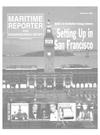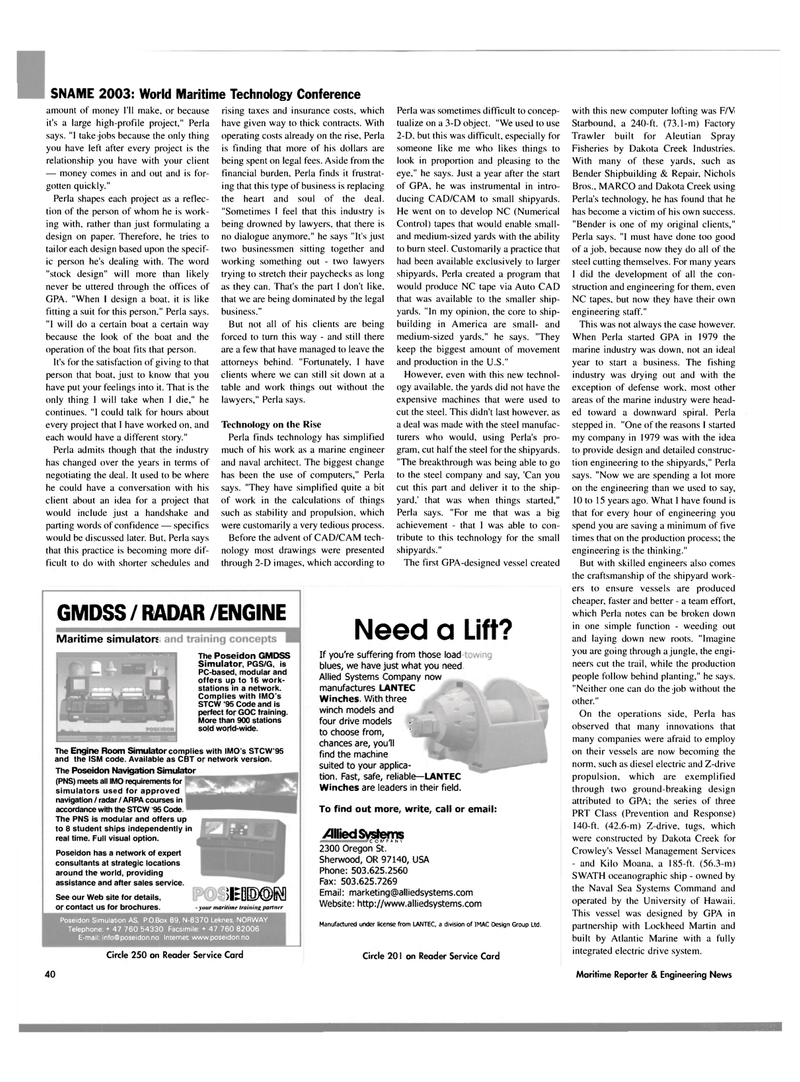
Page 40: of Maritime Reporter Magazine (September 2003)
Read this page in Pdf, Flash or Html5 edition of September 2003 Maritime Reporter Magazine
SNAME 2003: World Maritime Technology Conference amount of money I'll make, or because it's a large high-profile project," Perla says. "I take jobs because the only thing you have left after every project is the relationship you have with your client — money comes in and out and is for- gotten quickly."
Perla shapes each project as a reflec- tion of the person of whom he is work- ing with, rather than just formulating a design on paper. Therefore, he tries to tailor each design based upon the specif- ic person he's dealing with. The word "stock design" will more than likely never be uttered through the offices of
GPA. "When 1 design a boat, it is like fitting a suit for this person," Perla says. "I will do a certain boat a certain way because the look of the boat and the operation of the boat fits that person.
It's for the satisfaction of giving to that person that boat, just to know that you have put your feelings into it. That is the only thing I will take when I die," he continues. "I could talk for hours about every project that I have worked on, and each would have a different story."
Perla admits though that the industry has changed over the years in terms of negotiating the deal. It used to be where he could have a conversation with his client about an idea for a project that would include just a handshake and parting words of confidence — specifics would be discussed later. But, Perla says that this practice is becoming more dif- ficult to do with shorter schedules and rising taxes and insurance costs, which have given way to thick contracts. With operating costs already on the rise, Perla is finding that more of his dollars are being spent on legal fees. Aside from the financial burden, Perla finds it frustrat- ing that this type of business is replacing the heart and soul of the deal. "Sometimes I feel that this industry is being drowned by lawyers, that there is no dialogue anymore." he says "It's just two businessmen sitting together and working something out - two lawyers trying to stretch their paychecks as long as they can. That's the part I don't like, that we are being dominated by the legal business."
But not all of his clients are being forced to turn this way - and still there are a few that have managed to leave the attorneys behind. "Fortunately, I have clients where we can still sit down at a table and work things out without the lawyers," Perla says.
Technology on the Rise
Perla finds technology has simplified much of his work as a marine engineer and naval architect. The biggest change has been the use of computers," Perla says. "They have simplified quite a bit of work in the calculations of things such as stability and propulsion, which were customarily a very tedious process.
Before the advent of CAD/CAM tech- nology most drawings were presented through 2-D images, which according to
Perla was sometimes difficult to concep- tualize on a 3-D object. "We used to use 2-D. but this was difficult, especially for someone like me who likes things to look in proportion and pleasing to the eye," he says. Just a year after the start of GPA, he was instrumental in intro- ducing CAD/CAM to small shipyards.
He went on to develop NC (Numerical
Control) tapes that would enable small- and medium-sized yards with the ability to burn steel. Customarily a practice that had been available exclusively to larger shipyards, Perla created a program that would produce NC tape via Auto CAD that was available to the smaller ship- yards. "In my opinion, the core to ship- building in America are small- and medium-sized yards," he says. "They keep the biggest amount of movement and production in the U.S."
However, even with this new technol- ogy available, the yards did not have the expensive machines that were used to cut the steel. This didn't last however, as a deal was made with the steel manufac- turers who would, using Perla's pro- gram, cut half the steel for the shipyards. "The breakthrough was being able to go to the steel company and say, 'Can you cut this part and deliver it to the ship- yard.' that was when things started,"
Perla says. "For me that was a big achievement - that I was able to con- tribute to this technology for the small shipyards."
The first GPA-designed vessel created
GMDSS / RADAR /ENGINE
Maritim^imulat^
The Poseidon GMDSS
Simulator, PGS/G, is
PC-based, modular and offers up to 16 work- stations in a network.
Complies with IMO's
STCW '95 Code and is perfect for GOC training.
More than 900 stations sold world-wide.
The Engine Room Simulator complies with IMO's STCW'95 and the ISM code. Available as CBT or network version.
The Poseidon Navigation Simulator (PNS) meets all IMO requirements for simulators used for approved navigation / radar / ARPA courses in accordance with the STCW '95 Code.
The PNS is modular and offers up to 8 student ships independently in real time. Full visual option.
Poseidon has a network of expert consultants at strategic locations around the world, providing assistance and after sales service.
See our Web site for details, or contact us for brochures.
IIEBDON - your maritime training partner
Poseidon Simulation AS, P.O.Box 89, N-8370 Leknes, NORWAY
Telephone: + 47 760 54330 Facsimile: + 47 760 82006
E-mail: [email protected] Internet www.poseidon.no
Circle 250 on Reader Service Card
Need a Lift?
If you're suffering from those load blues, we have just what you need
Allied Systems Company now manufactures LANTEC
Winches. With three winch models and four drive models | to choose from, " chances are, you'll find the machine suited to your applica- tion. Fast, safe, reliable—LANTEC
Winches are leaders in their field.
To find out more, write, call or email: /lllied Systems /—mm—mmmmmmmmmM COMPANY 2300 Oregon St.
Sherwood, OR 97140, USA
Phone: 503.625.2560
Fax: 503.625.7269
Email: [email protected]
Website: http://www.alliedsystems.com
Manufactured under license from LANTEC, a division of IMAC Design Group Ltd.
Circle 201 on Reader Service Card with this new computer lofting was F/V
Starbound, a 240-ft. (73.1-m) Factory
Trawler built for Aleutian Spray
Fisheries by Dakota Creek Industries.
With many of these yards, such as
Bender Shipbuilding & Repair. Nichols
Bros., MARCO and Dakota Creek using
Perla's technology, he has found that he has become a victim of his own success. "Bender is one of my original clients,"
Perla says. "I must have done too good of a job, because now they do all of the steel cutting themselves. For many years
I did the development of all the con- struction and engineering for them, even
NC tapes, but now they have their own engineering staff."
This was not always the case however.
When Perla started GPA in 1979 the marine industry was down, not an ideal year to start a business. The fishing industry was drying out and with the exception of defense work, most other areas of the marine industry were head- ed toward a downward spiral. Perla stepped in. "One of the reasons 1 started my company in 1979 was with the idea to provide design and detailed construc- tion engineering to the shipyards," Perla says. "Now we are spending a lot more on the engineering than we used to say, 10 to 15 years ago. What I have found is that for every hour of engineering you spend you are saving a minimum of five times that on the production process; the engineering is the thinking."
But with skilled engineers also comes the craftsmanship of the shipyard work- ers to ensure vessels are produced cheaper, faster and better - a team effort, which Perla notes can be broken down in one simple function - weeding out and laying down new roots. "Imagine you are going through a jungle, the engi- neers cut the trail, while the production people follow behind planting," he says. "Neither one can do the job without the other."
On the operations side, Perla has observed that many innovations that many companies were afraid to employ on their vessels are now becoming the norm, such as diesel electric and Z-drive propulsion, which are exemplified through two ground-breaking design attributed to GPA; the series of three
PRT Class (Prevention and Response) 140-ft. (42.6-m) Z-drive, tugs, which were constructed by Dakota Creek for
Crowley's Vessel Management Services - and Kilo Moana, a 185-ft. (56.3-m)
SWATH oceanographic ship - owned by the Naval Sea Systems Command and operated by the University of Hawaii.
This vessel was designed by GPA in partnership with Lockheed Martin and built by Atlantic Marine with a fully integrated electric drive system. 40 Maritime Reporter & Engineering News

 39
39

 41
41
